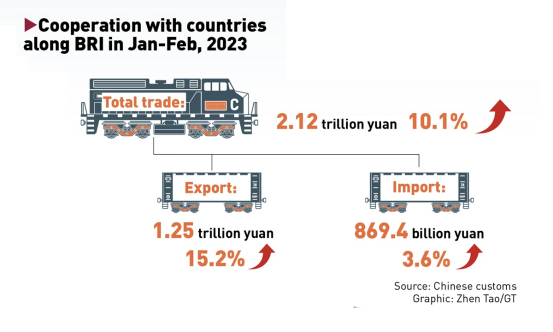近日,《环球时报》报道第十四届全国人大代表,辽宁省第十四届人大常委会委员,威尼斯集团网站官网党委副书记、校长余淼杰教授的观点,现将原文及链接转载如下:
Tapping vast potential of BRI in next decade a focus of two sessions


A China-Europe freight train from Kazakhstan arrives in Xi'an, Northwest China's Shaanxi Province on January 13, 2023. Photo: VCG
Deputies and members at the ongoing two sessions have brought their motions and proposals on how to tap into the vast potential of the China-proposed Belt and Road Initiative (BRI), as the widely supported initiative enters its 10th year.
From fostering preparedness of local ability to better connect with the initiative to opening up new venues to cater to the specific need of BRI markets, the proposals covered a wide range of issues ranging from infrastructure construction to financing and vocational training.
Yu Miaojie, a deputy to the National People's Congress (NPC), brought a motion that Northeast China's Liaoning Province could build a city cluster centered around the provincial capital Shenyang and major port city Dalian as the bulk of what he calls a Northeast sea-to-land passage that includes the China-Mongolia-Russia Economic Corridor and the China-Japan-South Korea free trade zone as its two wings.
Yu, the president of Liaoning University, predicted in a motion shared with the Global Times that from 2023 or the entire period of the 14th Five-Year Plan period (2021-25), the BRI trade will steadily account for roughly one-third of China's entire foreign trade and the BRI markets will become a major growth driver for China's foreign trade.
Tan Yueheng, a member of the National Committee of the Chinese People's Political Consultative Conference (CPPCC) and chief executive of BOCOM International, suggested that the Chinese mainland and Hong Kong should jointly build a BRI financing board at the Hong Kong Stock Exchange as a new venue to cater to the financing needs of the BRI markets.
Such a board could tap equity and bond financing, and other unique types of investment and financing, according to a Shanghai Securities News interview with Tan.
Big BRI projects with a long construction period and relatively stable return prospects could issue bonds in Hong Kong, Tan's proposal also suggested.
Liu Zhenfang, an NPC deputy and chairman of the China State Railway Group, identified further deepening the connectivity of infrastructure, joint consulting related rules and regulations, and sharing the fruits of development as the mission guiding the next phase of work of the state railway operator, according to a press release the company sent to the Global Times.
In addition to wide global support, the proposals by deputies and political advisors from different Chinese localities, different sectors, and different organizations showed the initiative has received an active response from all levels of Chinese society in an all-round manner, Wan Zhe, an economist and professor at the Belt and Road School of Beijing Normal University, told the Global Times on Thursday.
Against the backdrop of the US' escalating crackdown on China, the nascent BRI markets also encapsulate China's optimized trade structure.
The BRI has offered Chinese companies, in their process of going abroad, a grand platform, Wan said.
In 2022, China's trade with the BRI markets accounted for 32.9 percent of its total foreign trade, up 3.2 percentage points from that of 2021.
In the first two months of 2023, China's trade with the BRI market registered a 10.1-percent-increase year-on-year, totaling 2.12 trillion yuan, whereas total foreign trade edged down 0.8 percent year-on-year, data from the General Administration of Customs showed on Tuesday.

The first BRI decade
China will make great efforts toward the successful holding of the the first China-Central Asia Summit and 3rd Belt and Road Forum for International Cooperation, Foreign Minister Qin Gang said at a press conference on Tuesday during the two sessions.
Since it was proposed in 2013, the BRI has brought material benefits to the countries and regions involved, building a broad path for common development, Qin said.
Over the last decade, the BRI galvanized nearly $1 trillion in investments and established more than 3,000 new cooperative projects, creating 420,000 jobs for the countries and regions involved, and lifting approximately 40 million people out of poverty, the Chinese Foreign Minister noted.
The BRI is a high-quality public good initiated by China and jointly contributed to by all partners, whose benefits are shared by the world. It has attracted the participation of more than three-fourths of the countries in the world and 32 international organizations, Qin stressed.
"On the one hand, after a decade of foundation-laying work, people, not only in China but around the world, are inspired by the great achievements of the BRI, which has beaten the expectations of many," Liu Ying, a research fellow at the Chongyang Institute for Financial Studies, Renmin University of China, told the Global Times on Thursday.
On the other hand, the BRI development is also faced with challenges from the COVID-19 pandemic, geopolitical conflicts, and supply chain shocks, Liu said, noting that these issues need to be figured out with the BRI spirit of extensive consultation, joint contribution, and shared benefit.
"China welcomes other initiatives of development that are not ideologically driven and is happy to see them succeed if they don't contain geopolitical agenda," Qin said, referring to alternative programs and initiatives by Western countries.
The ideas by NPC deputies and political advisors will help lay down concrete work in the BRI's second decade through friendly partnerships with countries and global institutions, Liu with Renmin University of China said, adding that these connectivity programs will enhance the representation and discourse power of the BRI countries and regions in global governance.
Link to the text:Tapping vast potential of BRI in next decade a focus of two sessions - Global Times